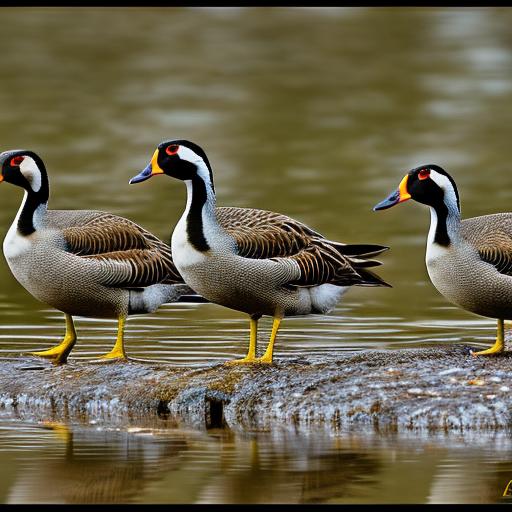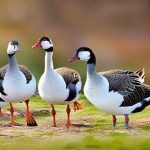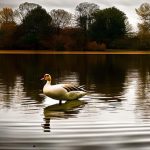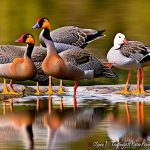Canadian Geese, also known as Canada Geese, are a familiar sight in the United Kingdom. These large waterfowl have become a permanent resident in the UK, despite being native to North America. The presence of Canadian Geese in the UK can be traced back to the 17th century when they were introduced as ornamental birds in parks and estates. Over time, some of these birds escaped or were released into the wild, establishing feral populations that have thrived ever since.
Canadian Geese are easily recognizable by their distinctive black heads and necks, white cheeks, and brown bodies. They have a wingspan of up to six feet and can weigh between 5 and 14 pounds. These geese are highly adaptable and can be found in a variety of habitats, including lakes, rivers, ponds, and even urban areas.
Key Takeaways
- Canadian geese were introduced to the UK in the 17th century as ornamental birds.
- Understanding the behaviour of Canadian geese can help prevent conflicts with humans.
- Canadian geese play an important role in the UK’s ecosystem and should be protected.
- Overpopulation of Canadian geese can lead to negative impacts on the environment and human health.
- Tips for keeping Canadian geese away from residential areas include using deterrents and removing food sources.
Understanding the Behavior of Canadian Geese
Mating habits and nesting behavior: Canadian Geese are monogamous birds that form lifelong pair bonds. They typically mate for life and return to the same nesting site year after year. The breeding season for Canadian Geese begins in late winter or early spring. During this time, they engage in elaborate courtship displays, including honking calls and head bobbing. Once a pair has formed, they will build a nest together on land near water, using grasses, twigs, and feathers.
Migration patterns and seasonal movements: Canadian Geese are known for their long-distance migrations. In the UK, however, many populations have become non-migratory due to the availability of food and suitable habitat year-round. Some populations still undertake short-distance migrations within the country, moving between breeding sites and wintering grounds. These movements are influenced by factors such as food availability and weather conditions.
Social behavior and communication: Canadian Geese are highly social birds that live in large flocks. They communicate with each other through a variety of vocalizations, including honks, hisses, and grunts. These calls serve as a means of communication within the flock, helping to maintain group cohesion and alerting others to potential threats. Canadian Geese also use body language, such as head bobbing and wing flapping, to communicate with each other.
The Importance of Keeping Canadian Geese in the UK
Ecological significance of Canadian Geese in the UK: Canadian Geese play an important role in the ecosystem of the UK. They help to disperse seeds through their droppings, contributing to the spread of plant species. They also graze on grasses and aquatic vegetation, helping to control plant growth and maintain healthy habitats for other wildlife. Additionally, Canadian Geese provide food for predators such as foxes and birds of prey.
Economic benefits of Canadian Geese to local communities: The presence of Canadian Geese can have economic benefits for local communities. They attract tourists and birdwatchers who come to observe these magnificent birds in their natural habitat. This can boost local businesses such as hotels, restaurants, and tour operators. Additionally, hunting opportunities for Canadian Geese can generate revenue through licensing fees and sales of hunting permits.
Cultural and recreational value of Canadian Geese in the UK: Canadian Geese have become an integral part of the cultural landscape in the UK. They are often featured in artwork, literature, and folklore, symbolizing the beauty and diversity of nature. Many people enjoy watching and photographing these birds, finding solace and inspiration in their graceful presence. The sight and sound of a flock of Canadian Geese flying overhead is a familiar and cherished experience for many.
The Negative Impact of Canadian Geese on the Environment
Damage to crops and vegetation: One of the main concerns associated with Canadian Geese is their impact on agricultural crops and vegetation. These birds have a voracious appetite and can cause significant damage to crops such as wheat, barley, and corn. They also graze on grasses and aquatic vegetation, which can lead to the destruction of sensitive habitats and the loss of plant species diversity.
Water pollution and erosion: Canadian Geese are known for their copious droppings, which can accumulate in large quantities near water bodies. This can lead to water pollution, as the feces contain high levels of nutrients such as nitrogen and phosphorus. Excessive nutrient levels can cause algal blooms, leading to oxygen depletion and the death of fish and other aquatic organisms. Additionally, the constant grazing of Canadian Geese can contribute to soil erosion, especially in areas with fragile or sensitive vegetation.
Health risks associated with Canadian Geese droppings: The presence of Canadian Geese droppings in public areas can pose health risks to humans. The feces can contain bacteria such as E. coli and Salmonella, which can cause gastrointestinal illnesses if ingested. In addition, the droppings can create slippery surfaces, increasing the risk of falls and injuries. It is important for individuals to take precautions when coming into contact with Canadian Geese droppings, such as washing hands thoroughly and avoiding direct contact.
Tips for Keeping Canadian Geese Away from Residential Areas
Use of physical barriers and deterrents: One effective way to keep Canadian Geese away from residential areas is to install physical barriers such as fences or netting. These barriers should be at least three feet high to prevent the geese from accessing the area. Additionally, there are various deterrents available that can be used to discourage geese from settling in unwanted areas. These include noise-making devices, motion-activated sprinklers, and visual deterrents such as scarecrows or reflective tape.
Modification of habitat to discourage nesting: Canadian Geese prefer open areas near water bodies for nesting. By modifying the habitat to make it less suitable for nesting, it is possible to discourage geese from settling in residential areas. This can be done by planting dense vegetation or installing rocks or gravel in potential nesting sites. It is important to consult with local authorities or wildlife experts before making any modifications to ensure compliance with regulations and to avoid causing harm to other wildlife species.
Removal of food sources: Canadian Geese are attracted to areas with abundant food sources. By removing or reducing these food sources, it is possible to discourage geese from frequenting residential areas. This can be done by cleaning up spilled birdseed or pet food, covering compost piles, and removing fallen fruits or berries. It is important to be consistent and persistent in removing food sources, as geese are quick to adapt and may return if they find a new food source.
Feeding Canadian Geese: What to Feed and What Not to Feed
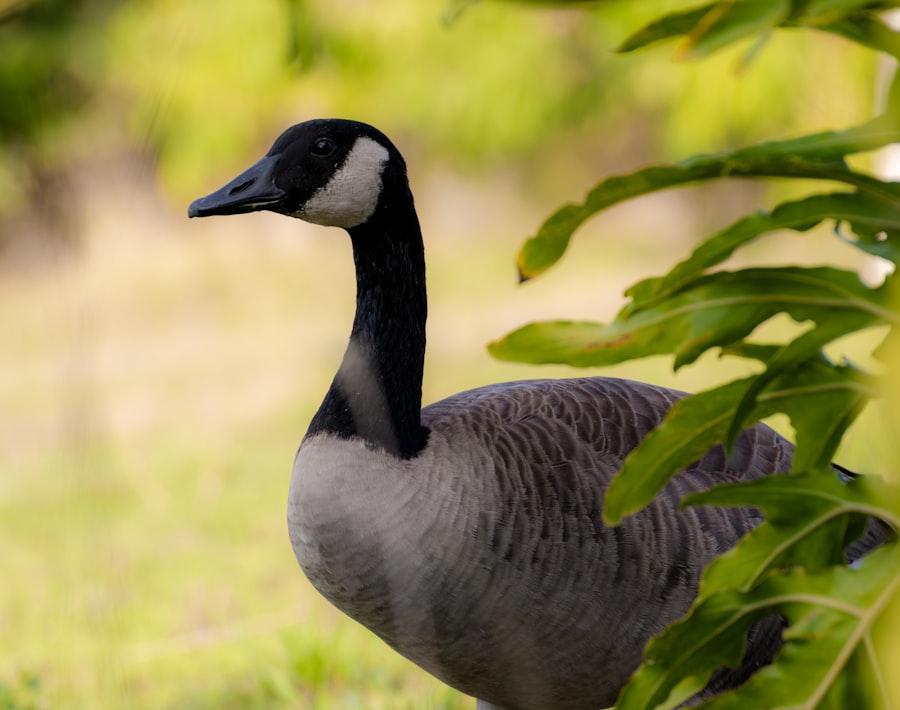
Appropriate foods for Canadian Geese: If you choose to feed Canadian Geese, it is important to provide them with appropriate foods that are nutritious and safe for their health. Suitable foods include grains such as cracked corn, wheat, or barley, as well as leafy greens such as lettuce or spinach. It is best to scatter the food on the ground rather than feeding them from your hand, as this can help prevent aggressive behavior and reduce the risk of injury.
Harmful foods that can cause health problems: There are certain foods that should be avoided when feeding Canadian Geese, as they can cause health problems or nutritional imbalances. These include bread, which lacks essential nutrients and can lead to malnutrition in geese. Additionally, feeding geese processed foods such as chips or cookies can contribute to obesity and other health issues. It is important to remember that feeding geese should be done in moderation and as a supplement to their natural diet.
The importance of not feeding Canadian Geese in residential areas: While feeding Canadian Geese can be a rewarding experience, it is important to avoid feeding them in residential areas. Feeding geese in these areas can lead to an overpopulation of geese, as they become dependent on human-provided food and lose their natural foraging instincts. This can result in increased competition for resources and the spread of diseases among the geese. It is best to enjoy the presence of Canadian Geese in their natural habitat and observe them from a distance.
The Dangers of Overpopulation of Canadian Geese
Increased competition for resources: When Canadian Geese populations become overpopulated, there is increased competition for limited resources such as food and nesting sites. This can lead to aggression and territorial disputes among the geese, as they try to secure their share of resources. Overpopulation can also result in the degradation of habitats, as the geese overgraze on vegetation and cause damage to sensitive ecosystems.
Spread of diseases and parasites: Overpopulation of Canadian Geese can increase the risk of disease transmission among the birds. Crowded conditions and close contact between individuals provide ideal conditions for the spread of diseases such as avian influenza or botulism. Additionally, overpopulated geese populations can attract parasites such as ticks or fleas, which can pose health risks to both humans and other wildlife species.
Negative impact on other wildlife species: When Canadian Geese populations become too large, they can have a negative impact on other wildlife species. The overgrazing of vegetation by geese can reduce food availability for other herbivores, leading to competition and potential population declines. Additionally, the presence of large numbers of geese can disrupt nesting and breeding behaviors of other bird species, leading to reduced reproductive success.
The Role of Wildlife Conservation in Protecting Canadian Geese
Conservation efforts to protect Canadian Geese in the UK: Wildlife conservation organizations in the UK play a crucial role in protecting Canadian Geese and their habitats. These organizations work to monitor and manage geese populations, conduct research on their behavior and ecology, and raise awareness about the importance of conserving these birds. They also collaborate with government agencies, local communities, and landowners to implement conservation measures and promote responsible behavior towards Canadian Geese.
Importance of monitoring and managing Canadian Geese populations: Monitoring and managing Canadian Geese populations is essential for maintaining a balance between the needs of the geese and the interests of humans. By monitoring population sizes and movements, conservationists can identify areas where geese populations are becoming overpopulated or causing significant damage. This information can then be used to implement management strategies such as habitat modification or culling to reduce population sizes or mitigate negative impacts.
Collaboration between government agencies, conservation organizations, and local communities: Protecting Canadian Geese requires collaboration between various stakeholders, including government agencies, conservation organizations, and local communities. Government agencies play a crucial role in setting regulations and policies that protect geese and their habitats. Conservation organizations provide expertise and resources for research, monitoring, and management efforts. Local communities can contribute by supporting conservation initiatives, reporting sightings or issues related to geese, and practicing responsible behavior towards these birds.
The Benefits of Coexisting with Canadian Geese in the UK
Opportunities for wildlife viewing and photography: The presence of Canadian Geese in the UK provides opportunities for wildlife viewing and photography. Many people enjoy observing these birds in their natural habitat, capturing their beauty and grace through photography or simply appreciating their presence. The sight of a flock of geese flying overhead or swimming gracefully on a lake can be a source of inspiration and wonder.
Educational and research opportunities: Canadian Geese offer valuable educational and research opportunities. Studying their behavior, ecology, and migration patterns can provide insights into the natural world and contribute to our understanding of wildlife conservation. Additionally, Canadian Geese can serve as ambassadors for environmental education, helping to raise awareness about the importance of protecting and conserving our natural resources.
Promotion of environmental awareness and conservation: The presence of Canadian Geese in the UK can promote environmental awareness and conservation. These birds serve as a reminder of the interconnectedness of all living beings and the importance of preserving biodiversity. By appreciating and respecting the natural world, individuals and communities can become more engaged in conservation efforts and take action to protect the environment for future generations.
Maintaining a Balance between Canadian Geese and Human Activities
Maintaining a balance between human activities and the needs of Canadian Geese is essential for their long-term survival and the well-being of ecosystems. It is important to recognize the ecological significance of these birds and their role in maintaining healthy habitats. At the same time, it is necessary to address the negative impacts that overpopulation can have on the environment, agriculture, and public health.
Encouraging responsible behavior towards Canadian Geese is crucial. This includes not feeding them in residential areas, avoiding disturbance of nesting sites, and following regulations and guidelines set by local authorities. By taking these actions, individuals and communities can contribute to the conservation of Canadian Geese and ensure that future generations can continue to enjoy their presence in the UK.
In conclusion, Canadian Geese have become an integral part of the UK’s natural landscape. Their presence brings both benefits and challenges, highlighting the need for responsible management and conservation efforts. By understanding their behavior, appreciating their ecological significance, and promoting coexistence with these magnificent birds, we can ensure a harmonious relationship between humans and Canadian Geese in the UK.
If you’re interested in keeping Canadian geese in the UK, you might also want to check out this informative article on converting a shed into a chicken coop. It provides valuable insights and practical tips on how to repurpose existing structures to create a suitable habitat for your feathered friends. To learn more about this topic, click here: https://poultrywizard.com/keeping-chickens/convert-shed-to-chicken-coop/. Additionally, if you’re looking for guidance on choosing the best type of coop for your chickens, this article offers a comprehensive overview of different options available. Discover which coop design suits your needs by visiting: https://poultrywizard.com/keeping-chickens/what-kind-of-coop-is-best-for-chickens/. Lastly, if you’re planning to build a chicken coop run, you’ll find a variety of helpful plans and ideas in this article. Explore the possibilities and start creating a safe and enjoyable space for your chickens by clicking here: https://poultrywizard.com/keeping-chickens/chicken-coop-run-plans/.
FAQs
What are Canadian geese?
Canadian geese, also known as Canada geese, are a species of waterfowl native to North America. They are known for their distinctive black heads and necks, white chinstrap markings, and brownish-gray bodies.
Why are Canadian geese found in the UK?
Canadian geese were introduced to the UK in the 17th century as ornamental birds in parks and estates. Over time, they have established themselves as a resident breeding species in the UK.
What problems do Canadian geese cause in the UK?
Canadian geese can cause a number of problems in the UK, including damage to crops, gardens, and golf courses, as well as fouling of public areas and waterways. They can also pose a hazard to aircraft and cause safety concerns in urban areas.
How can Canadian geese be managed in the UK?
There are a number of methods for managing Canadian geese in the UK, including habitat modification, egg addling, and culling. Non-lethal methods such as hazing and repellents can also be effective in deterring geese from certain areas.
Is it legal to cull Canadian geese in the UK?
Yes, it is legal to cull Canadian geese in the UK under certain circumstances. However, culling must be carried out in a humane and responsible manner, and a license is required from the relevant authorities.
Meet Walter, the feathered-friend fanatic of Florida! Nestled in the sunshine state, Walter struts through life with his feathered companions, clucking his way to happiness. With a coop that’s fancier than a five-star hotel, he’s the Don Juan of the chicken world. When he’s not teaching his hens to do the cha-cha, you’ll find him in a heated debate with his prized rooster, Sir Clucks-a-Lot. Walter’s poultry passion is no yolk; he’s the sunny-side-up guy you never knew you needed in your flock of friends!

